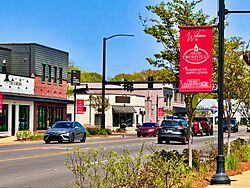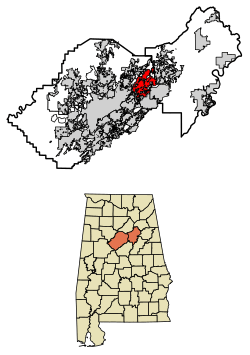Trussville, Alabama facts for kids
Quick facts for kids
Trussville, Alabama
|
|||
|---|---|---|---|
|
City
|
|||

Downtown Trussville
|
|||
|
|||
| Nickname(s):
The Gateway to Happy Living
|
|||

Location of Trussville in Jefferson County and St. Clair County, Alabama.
|
|||
| Country | United States | ||
| State | Alabama | ||
| Counties | Jefferson, St. Clair | ||
| Settled | 1821 | ||
| Incorporated | 1947 | ||
| Named for | Warren Truss | ||
| Area | |||
| • City | 35.18 sq mi (91.12 km2) | ||
| • Land | 34.67 sq mi (89.80 km2) | ||
| • Water | 0.51 sq mi (1.32 km2) | ||
| Elevation | 709 ft (216 m) | ||
| Population
(2020)
|
|||
| • City | 26,123 | ||
| • Density | 753.43/sq mi (290.90/km2) | ||
| • Metro | 1,145,067 | ||
| ZIP code |
35173
|
||
| Area code | 205 & 659 | ||
| FIPS code | 01-76944 | ||
| GNIS feature ID | 2405608 | ||
| Website | http://www.trussville.org/ | ||
Trussville is a city located in Alabama, a state in the United States. It's mostly in Jefferson County, but a small part is in St. Clair County. Trussville is like a neighbor to the bigger city of Birmingham. It's part of the larger Birmingham-Hoover area. In 2020, about 26,123 people lived here.
Contents
Where is Trussville Located?
Trussville is found at 33°37′18″N 86°35′47″W / 33.62167°N 86.59639°W. This means it's in the northern part of Alabama. The city covers about 35 square miles (91 square kilometers). Most of this area is land, with a small amount of water.
The Story of Trussville
How Trussville Started
The first European settler in this area was Warren Truss. He arrived in 1821 with his brothers. They built a mill on the Cahaba River. For many years, Trussville was mainly a farming community.
Things changed after the Civil War. A railway was built through the city. By 1886, a large furnace was built where Cahaba Elementary School is now. Trussville was officially listed as a community in 1890 and 1900. It later disappeared from records until it became a city again in 1947.
The Cahaba Project
A big part of Trussville's growth came from the Cahaba Project. This was a special plan in the 1930s. The government built over 250 homes here. The idea was to create a community for families with lower incomes.
The project was designed to be close enough to Birmingham. This way, people could travel to work. About 60 old houses were removed to make space. New homes were built for different families.
The project had a planned layout. There were 400 houses on good-sized lots. They surrounded a central green area called "The Mall." The plan was approved in 1936. The homes were built over the next two years. In total, 243 single-family houses and 44 duplexes were built.
These homes were rented to approved families. They had paved streets, sidewalks, and parks. A special entrance gate was built. Most homes were made of brick and wood. They had electricity, running water, and sewer connections. Each house even received two small oak trees to plant!
The Cahaba Project also had many community facilities. These included a swimming pool and schools. There was a co-op store, which was like a general store and library. Several churches were also started.
Residents formed a group called the Cahaba Association. They elected leaders and helped with community projects. They even had their own newspaper. The Cahaba Project was added to the National Register of Historic Places in 2002. This means it's a special historical place.
Becoming a City and Growing
On June 10, 1947, Trussville officially became a town. Then, on May 31, 1957, it became a city. Since then, Trussville has grown a lot. It's one of the fastest-growing areas near Birmingham.
Between 1980 and 2010, the city's population grew by over 500%. Many new homes and stores have been built. Two large shopping centers opened in the early 2000s. These are the Colonial Promenade at Trussville and the Colonial Promenade Tutwiler Farm. There is also the Pinnacle at Tutwiler Farm.
People of Trussville
| Historical population | |||
|---|---|---|---|
| Census | Pop. | %± | |
| 1890 | 462 | — | |
| 1900 | 742 | 60.6% | |
| 1950 | 1,575 | — | |
| 1960 | 2,510 | 59.4% | |
| 1970 | 2,985 | 18.9% | |
| 1980 | 3,507 | 17.5% | |
| 1990 | 8,266 | 135.7% | |
| 2000 | 12,924 | 56.4% | |
| 2010 | 19,933 | 54.2% | |
| 2020 | 26,123 | 31.1% | |
| U.S. Decennial Census | |||
Population in 2020
In 2020, Trussville had 26,123 people. There were 7,562 households living in the city. Most people in Trussville are White (81.04%). About 10.97% are Black or African American. Other groups like Asian, Native American, and people of mixed races also live here. About 2.17% of the population is Hispanic or Latino.
Education in Trussville
Trussville City Schools is the local school system. It serves about 4,269 students. The schools are known for being among the best in Alabama. The school mascot is the Husky, and the team colors are red and gray.
Before 2005, Trussville schools were part of the Jefferson County School System. The city decided to create its own school system in 2004. This happened because of money issues in the county schools. Trussville City Schools officially became separate in 2005.
The school system has five schools:
- Hewitt-Trussville High School (grades 9–12)
- Hewitt-Trussville Middle School (grades 6–8)
- Cahaba Elementary School (grades K-5)
- Magnolia Elementary School (grades K-5)
- Paine Elementary School (grades K-5)
Trussville's Economy
In 2014, the average family income in Trussville was about $94,875. Only a small number of families lived below the poverty line. The unemployment rate was 5.8%. Experts believe that job growth in the city will be good in the future.
Most people in Trussville (about 88%) work in "white collar" jobs. These are jobs that usually involve office work or professional skills. The most common jobs are in sales and administration. Many people also work in management, business, finance, healthcare, and education.
Trussville has seen a lot of new stores and businesses open. This is especially true along Highway 11 near the I-459 exit. There's also growth along Chalkville Mountain Road near the I-59 exit.
Local News
The local newspaper for Trussville is The Trussville Tribune. It covers news about crime, government, sports, and community events. The newspaper is published every Wednesday. It also provides news online.
Famous People from Trussville
Many notable people have connections to Trussville:
- Robert (Bobby) Bowden: A very famous college football coach. He coached the Florida State Seminoles for many years.
- John Amari: A judge and former politician in Alabama.
- Jay Barker: A former quarterback for the University of Alabama and an NFL player.
- Brandon Cox: A former quarterback for Auburn University.
- Matt Dickey: A professional basketball player.
- Jordan Fisher: An actor.
- Brent Key: A former football player and current coach for the Georgia Tech Yellow Jackets.
- Irene Latham: An author who writes poetry and stories for young adults.
- Malachi Moore: A strong safety for the Alabama Crimson Tide football team.
- Mike Mordecai: A former baseball player for teams like the Atlanta Braves.
- Robert J. Natter: A high-ranking Admiral in the United States Navy.
- Jason Standridge: A baseball player who played in the U.S. and Japan.
- Justin Tubbs: A former point guard for college basketball teams.
See also
 In Spanish: Trussville (Alabama) para niños
In Spanish: Trussville (Alabama) para niños



